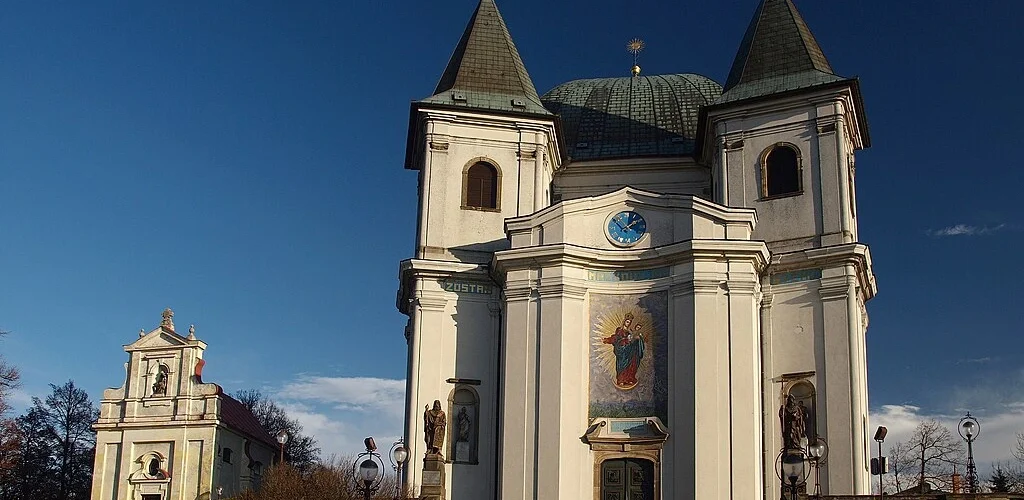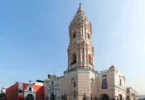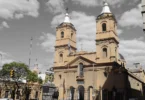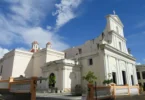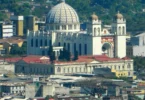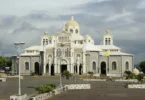Introduction
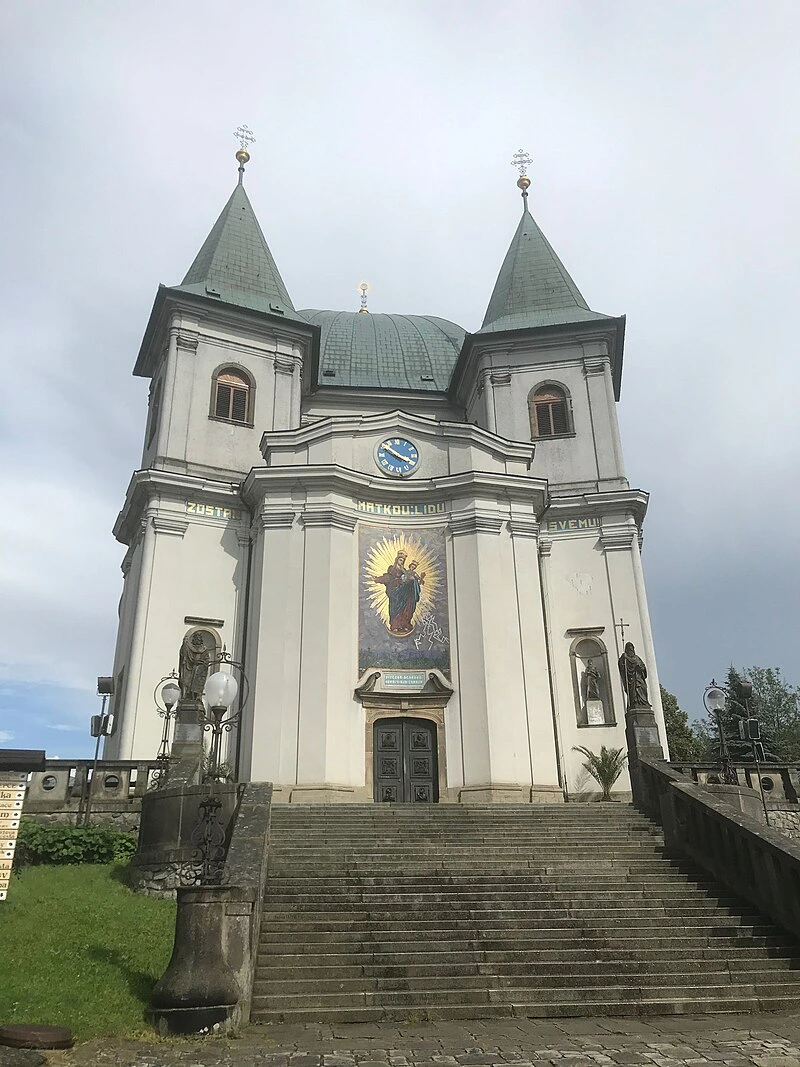
The Basilica of the Assumption of the Virgin Mary sits up on the hill at Svaty Hostyn. It’s not just any church it’s a basilica minor, and one of the most important Marian pilgrimage spots in Moravia. Places like Velehrad or Svatá Hora near Příbram in Bohemia are in the same league. The church itself was finished in 1747. It’s a late Baroque building with some classical touches, and it was designed by Ignaz Cyrani of Bolleshous, the architect who worked for the bishops in Olomouc. But things didn’t go smoothly for the church forever in 1784, during the Josephine reforms, it was actually shut down and deconsecrated. After that, it was left to fall apart no roof, no furnishings, nothing. It wasn’t until the mid-1800s that it was brought back to life. Local parishes pushed to save it, and eventually it was restored and made a church again. One of the standout things you’ll notice on the front of the church is the big mosaic of the Hostýn Madonna. It’s by Viktor Foerster, a mosaic artist from Prague, and he made it in 1912. The thing is huge 26 square meters and made up of about 260,000 tiny glass pieces that were specially brought in from Italy. In 2018, the whole pilgrimage site was declared a national cultural monument of the Czech Republic pretty well deserved, considering its history and importance.
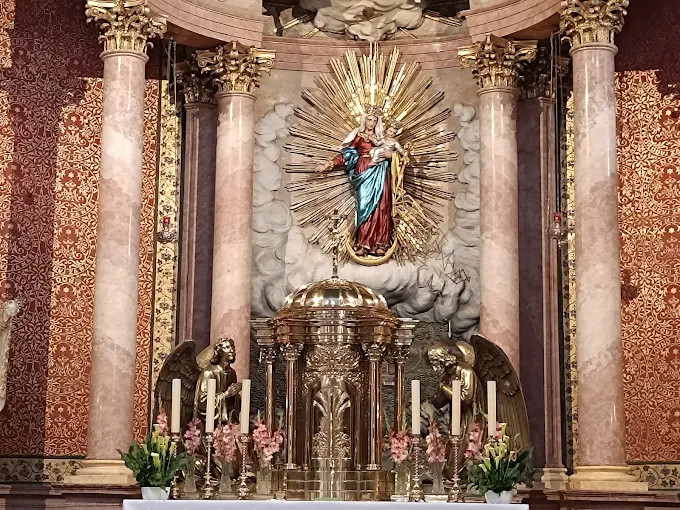
A Chapel, a Miracle, and a Legend
Way back in the late Middle Ages, there was already a small chapel standing on top of Hostýn hill. According to a local legend, during a brutal Tatar invasion in the 13th century, people fled to this hill to hide. On May 12, 1241, they prayed to the Virgin Mary, and apparently, she answered a spring burst out of the ground, a storm rolled in, and the Tatars were forced to retreat. The locals saw this as a miracle and built a chapel in her honor. From then on, people would return here every year to thank her calling her the Protector.
Another Invasion, Another Prayer
The hill wasn’t just remembered once. In 1662–1664, when the Turkish army invaded Moravia, people once again looked to Hostýn for protection. By then, the chapel had already been repaired and even got a new painting in 1628, thanks to the estate’s new owner, Václav von Lobkovic. This time, it showed the Virgin Mary Victorious holding baby Jesus, standing on a crescent moon, throwing lightning bolts at enemies. Pretty dramatic.
Building the Big Church
Starting around 1650, the Rottal family took ownership of Hostýn and played a big role in turning it into the major pilgrimage site it is today. In 1721, they laid the foundation stone for a new, bigger church. It took over 20 years to finish, with the final touches added under Franz Anton of Rottal. The design was likely by Josef Ignác Cyrani z Bolleshaus, an architect for the Olomouc bishops. The church was finally consecrated on July 28, 1748.
Fire and Decline
Not long after, in 1769, lightning struck the church, setting the roof and both towers on fire. It was so bad that three bells melted and the fourth one fell. But they managed to repair everything within two years. Then came 1784 and the Josephine reforms the church was shut down and stripped bare. No roof, no furniture. By the early 1800s, it was mostly ruins.
The Comeback Begins
Even in ruins, Hostýn never really lost its importance to people. In the 1830s, Bystřice’s parish priest, Bernard Reger, started a push to bring it back. Locals raised money, even Emperor Ferdinand the Good and his family chipped in. On May 10, 1841, construction officially started again exactly 600 years after the “Tatar rescue.” Bit by bit, they repaired the presbytery, the nave, the roof. In 1843, new towers and domes went up. The roof got temporary wooden shingles. The interior was slowly redone too a new main altar, a fresh statue of Virgin Mary Victorious by Brno sculptor Benedikt Edele, and a painting of Tatars running from lightning by Josef Haumann. The still-unfinished church was reconsecrated in July 1845.
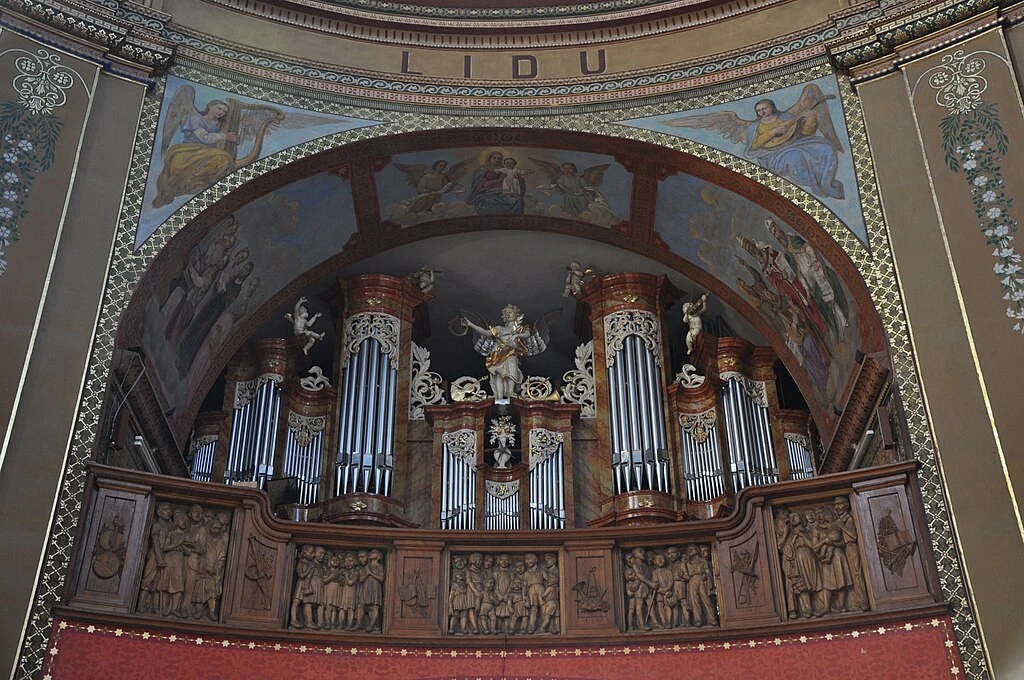
Step by Step Improvements
Over the next years, things kept improving bells, an organ, side altars, and a paved floor. In 1864, they added large statues of St. Cyril and Methodius on the front of the church, made by sculptor A. Beck from Kromeriz.
The Jesuits Take Over
In 1887, the Jesuits came to Hostýn and took charge of further renovations. Father Jan Cibulka organized much of the work and helped decorate the interior. Jan Zapletal Jr., a painter and restorer from Kroměříž, painted the inside of the church. František Obdržálek, a Jesuit himself, handled the decorative details. By 1890, the walls were filled with paintings of around 900 figures and faces. For the 650th anniversary of the original Hostýn miracle, the church was reconsecrated again this time in front of about 100,000 people, on August 15, 1891.
Mosaics, Metal, and More
In 1912, a massive mosaic of the Virgin Mary Victorious was added to the front of the church, made by Prague artist Viktor Foerster. In the following years, upgrades kept coming a new metal roof structure in 1929, cleaned and re-plastered walls in 1930, new wooden doors with bronze reliefs in 1933, and a new bronze altar in 1935 designed by architect Alois Spurný. It even got two statues of angels by sculptor Čeňek Vosmík.
War, Loss, and Long Silence
World War II hit hard. The church lost three bells, and for nearly fifty years, not much was done. One bright spot: in 1953, they bought a new organ from the Rieger-Kloss company, and a beautifully carved wooden railing was added to the choir area.
A Basilica Once Again
In 1971–1972, the wall paintings inside were restored. Then in 1982, Pope John Paul II officially elevated the church to the status of Minor Basilica.
After Communism: A Fresh Start
After the fall of the communist regime in 1989, things finally started looking up again. The whole pilgrimage site got a facelift. The church was renovated electric lighting fixed, organ upgraded, floor replaced with heating installed, the famous mosaic repaired, and the statues of St. Cyril and Methodius restored. In 1995, the Czech government allocated 2.6 million CZK for preservation work. In 2012, the basilica even got seven new bells, continuing its long legacy.
Architecture of Basilica of Our Lady of the Assumption, Hostýn, Czechia
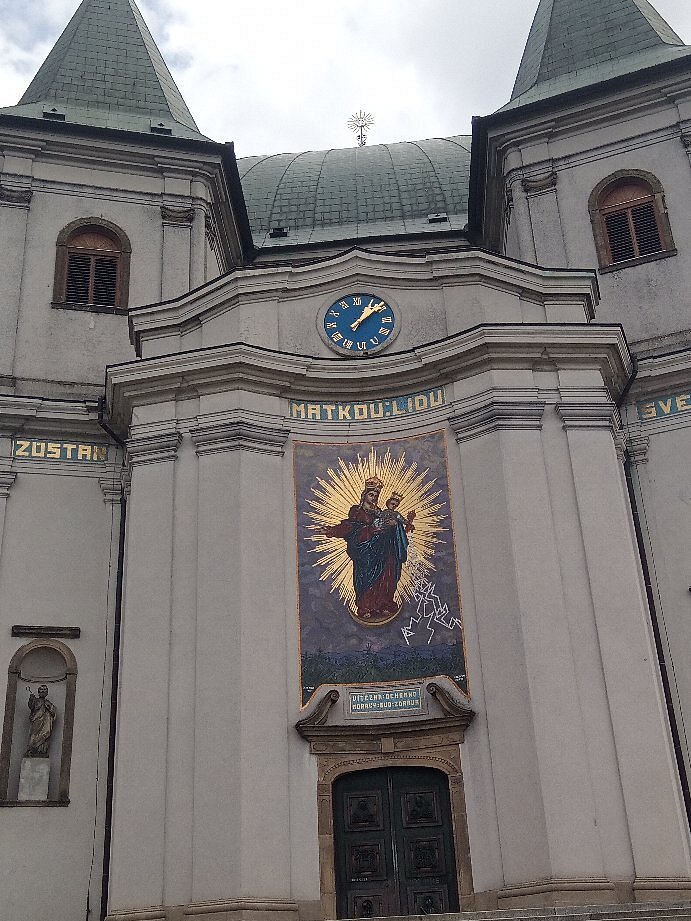
Architectural style: Baroque architecture
The basilica is a free-standing building in the late Baroque style on the top of the hill. A monumental stone staircase of 250 steps leads to it from the water chapel. The names of the donors who contributed to their construction were carved on the individual steps. The staircase connects two roads and divides them into three sections of varying lengths, each of which becomes wider as it approaches the church. At the foot of the staircase on the left side, on a platform between the trees, there is a life-size bronze statue of Christ (Divine Heart) by sculptor Cenek Vosmík from 1918. There are shopkeepers’ booths with devotional items, souvenirs, and other goods on both sides of the middle section of the staircase. At the corners of the staircase in front of the church stand life-size statues of St. Cyril and Methodius.
Exterior
The church itself is built in a late Baroque style, with a kind of flowing elegance that curves rather than stands stiff. It’s a single-nave church with two big towers rising from the front. From the ground, the building stretches around 40 meters long and 30 wide, with the top of the dome reaching just under 24 meters. Between the two towers, the front facade curves inward, creating this gentle wave-like shape around the main door. The entrance door itself is decorated with six square bronze plates you’ll see inscriptions like “IHS” and “MARIA” along with reliefs of Czech saints: Wenceslas, Adalbert, Ludmila, and Hedwig. But the thing that really catches your eye is the massive mosaic right above the door. It shows the Virgin Mary of the Holy Host, done in 1912 by Viktor Foerster. It’s 26 square meters, made from 260,000 tiny pieces of glass brought from Italy. Beneath it is a mosaic inscription that reads: “Vítězná ochrano Moravy, buď zdráva” which means “Victorious protector of Moravia, be well.” There’s also a clock set into the upper facade, and niches with statues of saints in the towers. If you walk around the church, you’ll see the whole building is wrapped in decorative stonework pilasters, cornices, arches all laid out in that elegant Baroque style. The dome roof is smooth and round, while the tower roofs are shaped like four-sided pyramids.

Interior
The entrance part under the porch leads into the main nave, over which a dome spans, illuminated by seven window openings. On the sides of the nave are two large niches with opposite side entrances, and chapels are set up in four narrower niches. They are separated by double pilasters that carry a massive cornice on which the dome rests. On the frieze under the cornice is an inscription around the perimeter: Victorious protector of Moravia, remain the mother of your people. The main nave is followed by a semicircular presbytery vaulted with a barrel vault. The nave is illuminated by six rectangular windows in individual side niches and seven elliptical windows in the dome. The eighth opening in the dome above the presbytery was subsequently walled up and a painting of the Coronation of the Virgin Mary was painted on its surface. The dome has a simple painting resembling a sky with 360 golden stars. In the middle is the coat of arms of the Laudon family, who owned the castle in Bystřice pod Hostýnem in the 19th century.At the main entrance hangs a commemorative cross made of cedar wood, which was brought from Kromeriz in 1845. Above the entrance to the choir is a memorial plaque of the greatest patron of Hostyn, AC Stojan, while the opposite memorial plaque commemorates the visit of the Viennese nuncio Granito di Belmonte to Hostýn. The musical choir’s arched band shows reformers and churchgoers singing around the Virgin Mary.
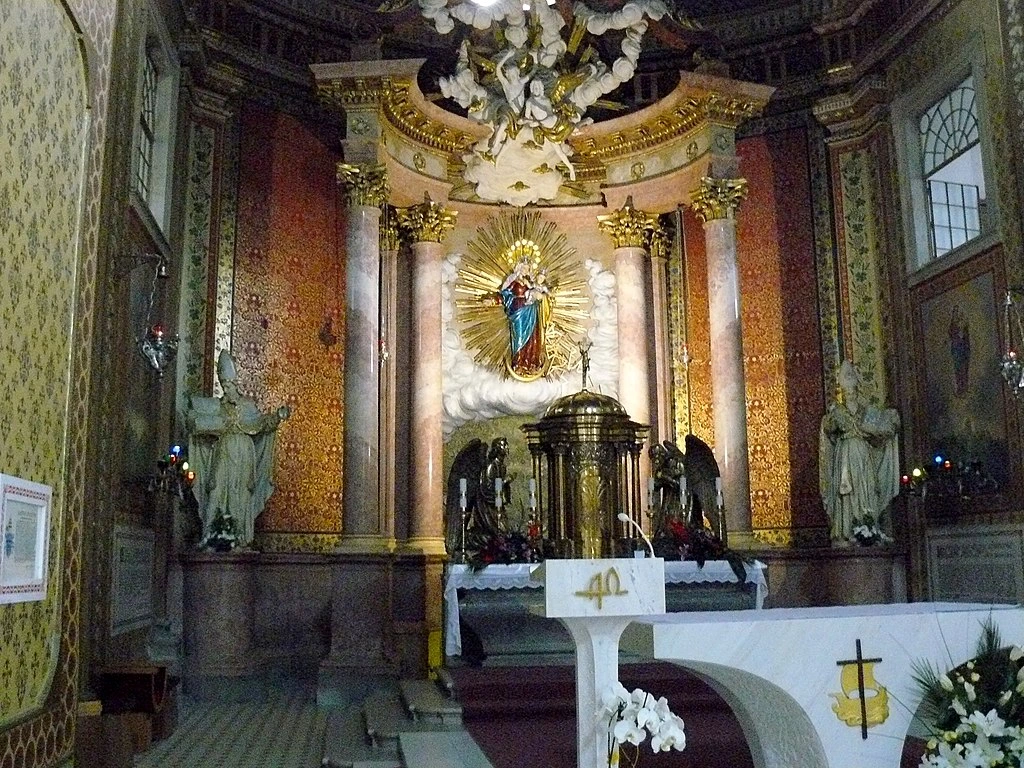
The Main Altar
The altarpiece of the main altar consists of a pair of Corinthian columns on a high plinth, supported by entablatures with a decorative canopy. Instead of an altarpiece, a statue of the Virgin Mary of Hostýn with the baby Jesus is mounted on the wall, and below it a relief depicting the miraculous humiliation of the Tatars. On the plinth, statues of St.Cyril (with a book) and Methodius (with a shell) are placed on the sides. The altar mensa is equipped with a bronze tabernacle topped with a crucifix, which was made by the academic sculptor Jan Tříska after the work of Josef Václav Myslbek. ek Vosmk created the adoring gilded angels on the sides. The idea of the altar, which is a copy of the Baroque altar from the episcopal cathedral in Brno, was created by the Benedictine monk Řehoř Wolný from Rajhrad , and the realization was entrusted to the Brno sculptor and carver Benedikt Edele. The painting around the round window above the altar, resembling a sunrise, is the work of B.Skarda from Brno.On the wall on both sides of the love statue, the entire Litany of Loreto is written in gold letters on a red background. In front of the main altar under the triumphal arch, a new canteen from the 1980s is built. Five murals in the arch’s vault depict the history of Hostyn. The presbytery has rich pictorial decoration. Above the entrances to the opposite sacristies are two angels on a golden background. Next to the entrance on the gospel side is a large painting of Our Lady the Protector, in the form worshipped since the 13th century. On the opposite (epistle) side is a painting of Our Lady the Victorious, who hovers above the buildings on the top of Hostýn. Below the paintings is a commemorative marble slab, commemorating the coronation ceremony of 1912. Under the cornices of the presbytery are six paintings of Czech patron saints: St. Hedwig, St. Cyril, St. John of Nepomuk, St. Wenceslas, St. St. Methodius and John of Sarkander.
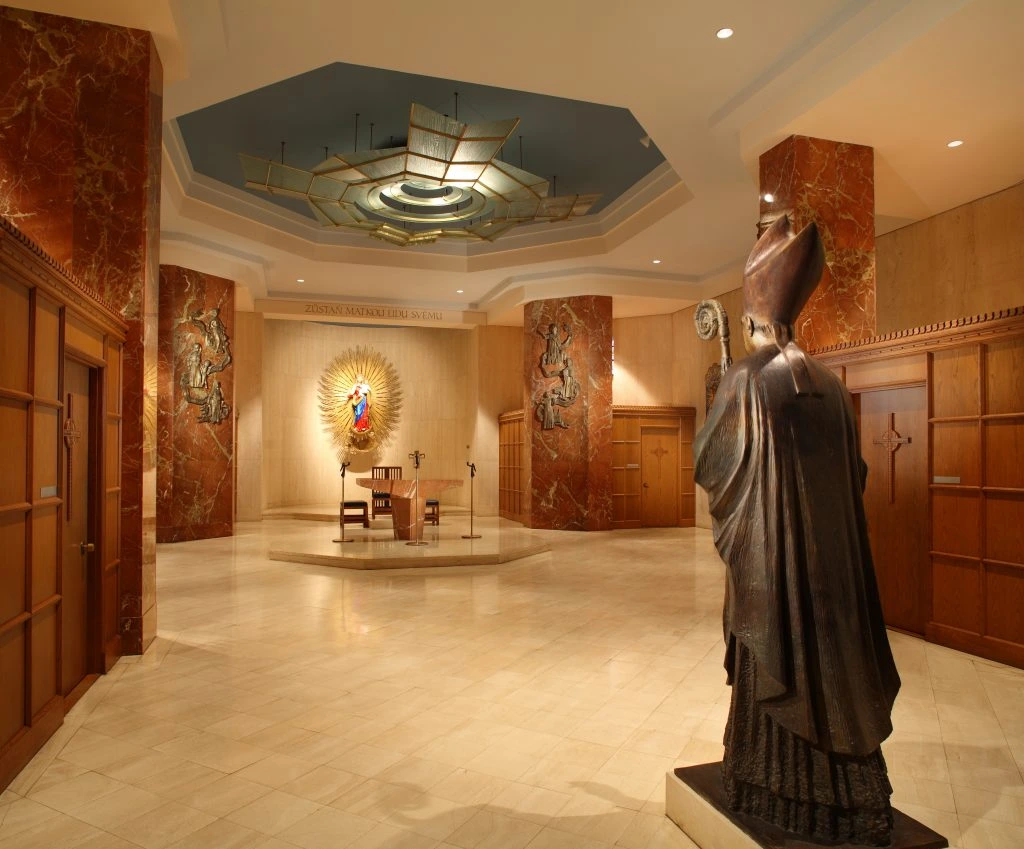
The Chapels Inside the Basilica
There are several small chapels inside the basilica, each one with its own character. On the left side near the main altar is the Chapel of St. Joseph. It has a painting called The Dream of St. Joseph, made by Jan Zapletal in 1846. Above the altar, the ceiling is painted with two groups of Czech saints, with the Virgin Mary in the middle. Just above the chapel, under the upper edge of the wall, you’ll see painted images of the evangelists Matthew and John, again with Mary between them. On the opposite side, to the right of the presbytery, is the Chapel of St. Valentine. There’s a painting there from 1845 by Leopold Ventruba, showing St. Valentine healing sick people. Above that are more saints and martyrs, mostly Jesuits, gathered around Mary. Painted near the ceiling are the evangelists Luke (with his lion) and Mark (with a bull), and between them is Mary again, this time as Our Lady of the Snows. This chapel also holds the remains of Saint John Neumann. Moving toward the middle of the church, on the left side of the nave, you’ll find the Chapel of St. Anne. The altarpiece shows St. Anne with the young Virgin Mary and Joachim, painted by Jan Prachař. On the ceiling, there are scenes with people who supported the church, with St. Anne in the background. An angel is shown guiding Father Martin Středa toward her, while Count Rottal stands on the other side holding a plan for the church. Up above, you’ll also see paintings of St. Augustine holding a child, and St. Jarolím, with Mary in the middle, holding a lily. On the right side of the nave is the Chapel of St. Sebastian. The altar painting shows Sebastian’s suffering, and the ceiling has a golden cross a symbol of Jesus along with a scene of final judgment. Above the chapel are two church fathers shown defending Mary’s divine motherhood. In the middle, Mary appears again, this time as the Mother of Good Counsel. Near the side entrances of the church, in little alcoves, are two more altars. One is for Our Lady of Lourdes and has a marble carving of St. Ignatius of Loyola. The other is for the Divine Heart of Jesus, with a carving of St. Francis of Assisi. Both were made by Ferdinand Neumann from Kromeriz. On the wall behind them, you’ll see a painting of Mary’s Assumption into heaven, and across from it, a picture of Mary as the victorious one, with Jaroslav of Sternberk defeating the Tatars, and pilgrims walking below toward the water chapel.
Feast Day
Feast Day : 15 August
The feast day of the Basilica of Our Lady of the Assumption in Hostýn takes place on August 15, which is the Feast of the Assumption of the Virgin Mary. This day marks the belief that Mary was taken up into Heaven, body and soul. It’s the most important annual celebration at the basilica, drawing thousands of pilgrims each year for Mass, prayer, and special events in honor of the Virgin Mary.
Church Mass Timing
Monday : 07:15 AM, 09:40 AM, 11:40 AM, 03:30 PM
Tuesday to Thursday : 07:15 AM, 09:40 AM, 11:40 AM
Friday : 07:15 AM , 09:40 AM, 11:40 AM, 04:45 PM
Saturday : 07:15 AM, 09:00 AM, 10:15 AM, 11:30 AM, 06:00 PM
Sunday : 07:15 AM, 09:00 AM, 10:15 AM, 11:30 AM, 2:45 PM
Church Opening Time:
Monday to Sunday : 7:00 am – 04:00 pm.
Contact Info
Address :Basilica of the Assumption of the Virgin Mary
Svatý Hostýn, 768 72 Chvalčov, Czechia.
Phone : +420 573 381 693
Accommodations
Connectivities
Airway
Basilica of Our Lady of the Assumption, Hostýn, Czechia, to Přerov Airport Na Letišti, distance 45 min (38.1 km) via Route 490.
Railway
Basilica of Our Lady of the Assumption, Hostýn, Czechia, to Železniční stanice Kojetín Nádražní, distance between 42 min (46.9 km) via D1.

